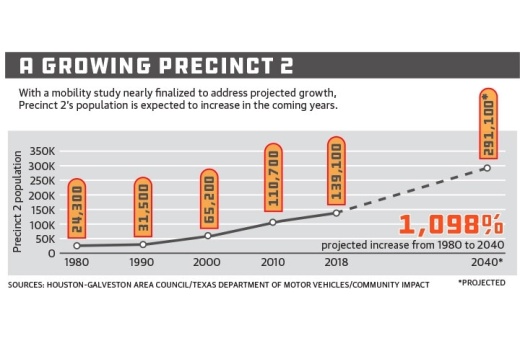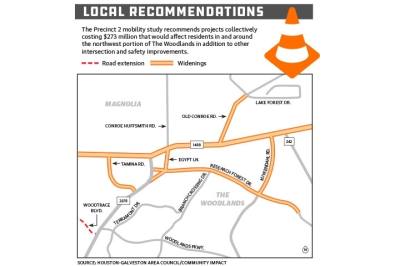A Montgomery County Precinct 2 mobility study requested by Precinct 2 Commissioner Charlie Riley and executed by the Houston-Galveston Area Council will be finalized this fall, recommending $3.6 billion in mobility improvements.
Although specific funding sources and construction timelines are unknown for the recommended projects, the study outlines the precinct’s needs for roadways, safety enhancements and transit upgrades, according to the H-GAC and a draft study shared in August.
This is the first mobility study done specifically for Precinct 2, although a thoroughfare plan was conducted in 2016 for the county as a whole and updated in 2021, according to H-GAC Project Manager Carlene Mullins and previous Community Impact reporting. Precinct 2 spans southwest Montgomery County from Magnolia to the northernmost area of The Woodlands.
Riley contacted the H-GAC in 2018 about doing the study, and Mullins said it began in September 2020 after two years were spent securing funding from the Texas Department of Transportation. Mullins said the study budget totaled $500,000 in federal funds with Precinct 2 contributing $100,000.
The H-GAC identified mobility needs before its first public meeting April 22, 2021, according to the study’s website, and the study is expected to be finalized this fall with minor changes, Mullins said.
Some of the projects called for in the study include extending the widening of FM 1488—underway between the Waller County line and FM 149—to I-45, and extending Woodtrace Boulevard to FM 2978.
While some of the roads in the study are maintained by the state, many of them are county maintained, and Riley said a future bond referendum to fund those county road projects could be possible.
A growing county
In 2020, Montgomery County had a population of 620,443, according to the U.S. Census Bureau’s decennial census. That is 6,492 more people than the Texas Demographics Center—which produces, interprets and publishes state demographic data—predicted in its 2018 population projections report.
The TDC also predicted that by 2040, the county will reach a population of 1.11 million residents.
“Growth in the North Houston region continues to progress north and northwest,” North Houston Association President Marlisa Briggs said in an interview. “We’ve got so many new developments [and] communities, and our population just keeps increasing.”
As the population increases, so does the number of cars on the roads. In 2021, 580,774 cars were registered in Montgomery County, which is a 31.5% increase from 2012, according to the Texas Department of Motor Vehicles.
Projects in and around The Woodlands
In The Woodlands, the mobility plan recommends new roads, widenings, intersection improvements and safety updates.
One of the bigger recommendations calls for widening FM 1488 to I-45 from four to six lanes. TxDOT is widening FM 1488 from the Waller County line to FM 149, set to wrap up in 2025, according to an Oct. 1 update.
Also recommended in the study are widening a portion of Research Forest Drive from FM 2978 to Cochrans Crossing Drive from four to six lanes; widening Tamina Road from FM 1488 to FM 2978 from two to four lanes; widening Old Conroe Road to FM 1488 from two to four lanes; widening Kuykendahl Road north of Research Forest Drive from two to four lanes; and widening Egypt Lane from FM 2978 to FM 1488.
These projects as well as a new road extension on Woodtrace Boulevard would cost an estimated $273 million in total if they were pursued, according to Precinct 2.
The Woodlands Township board of directors members have said extending Woodtrace Boulevard to FM 2978 could cause the same concerns for excessive traffic passing through The Woodlands that arose with a previously discussed Woodlands Parkway extension. Chair Gordy Bunch, who said he petitioned against a 2015 road bond that included that project, said he is also concerned about Woodtrace.
“The Woodlands Parkway extension has been rebranded Woodtrace Parkway,” he said in an Oct. 19 email. “With a new development, there could be a direct connection that would essentially have built a project our voters overwhelmingly rejected.”
He said the township has not received a formal presentation on the study and noted he would reach out to request one.
Director Shelley Sekula-Gibbs said the Research Forest Drive widening recommendation is also a concern for residents.
“Most don’t want more cut-through traffic coming into The Woodlands,” she said. “There is I think a majority opinion that this is not a good idea.”
Sekula-Gibbs said residents can learn more about regional transportation plans at a meeting scheduled at the Magnolia Event Center, 11659 FM 1488, Magnolia, at 6 p.m. Dec. 1.
Sekula-Gibbs said one option to improve traffic on the road without widening would be more dedicated right-hand turn lanes to help people to get out of the flow of traffic.
Riley has emphasized that the study is a list of recommendations.
“We’re not going to go out here and just start building roads just because they say this needs to be done,” Riley said. “It is going to be on an as-needed basis.”
Looking forward
Mullins said most of the projects called for in the long-range mobility study were in line with TxDOT’s recommendations and ongoing projects throughout Precinct 2, and once the study is finalized, it will be turned over to Riley and his office.
Riley said after receiving the finalized study, he and his office will determine the next steps.
To help fund projects recommended in the study, Riley said he sees the need for a future county road bond. Voters last approved a $280 million road bond in 2015, according to previous reporting.
“I think right after the first of the new year, we’re going to have to get serious about talking about figuring out a way to fund some of these projects,” Riley said. “A road bond is going to be about the only way we’re going to be able to do what we need to do in Montgomery County.”
Some projects could also be funded from the county’s toll road revenue, which has somewhere around $14 million to spend for roadway projects, Riley said.
“Every project on that study is one that we may or may not do,” Riley said. “We know that the majority of them may be done, but you’re talking [about] billions of dollars that they recommended in this study, and that’s always the biggest challenge we have is where we’re going to get the funding and who’s going to step up and help fund these projects.”






